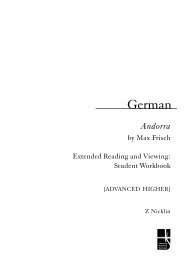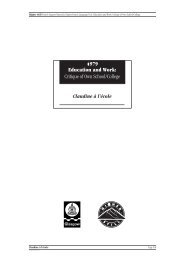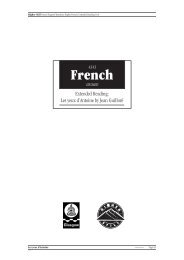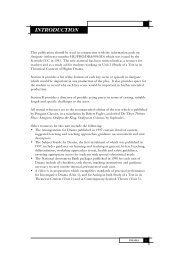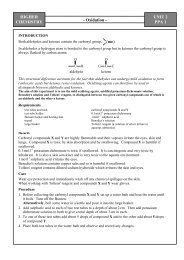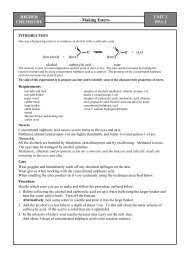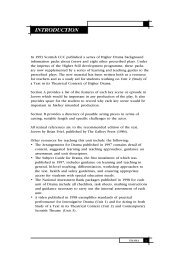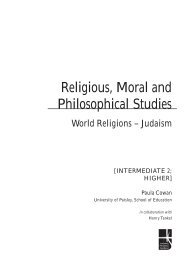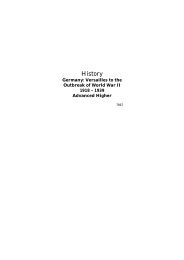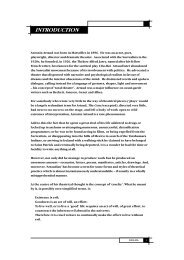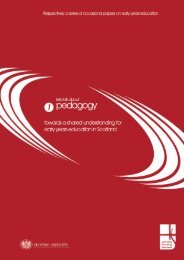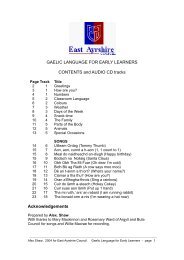The Reggio Emilia Approach to Early Years - Education Scotland
The Reggio Emilia Approach to Early Years - Education Scotland
The Reggio Emilia Approach to Early Years - Education Scotland
You also want an ePaper? Increase the reach of your titles
YUMPU automatically turns print PDFs into web optimized ePapers that Google loves.
When asked what participation means at a personal level parents responded in many ways.<br />
Below are some of their answers.<br />
�<br />
• It is a search for opportunities for more profound exchange, confrontation and<br />
reflection so that we ourselves continue <strong>to</strong> grow as people.<br />
• <strong>The</strong>re is a need not <strong>to</strong> delegate our own child’s education.<br />
• Curiosity<br />
• I see participation not just as personal, but also as social and cultural growth.<br />
<strong>The</strong> reciprocal relationships that exist between child, family, school and, indeed, community<br />
are therefore far-reaching indeed. To talk of a ‘link’ between families and home is <strong>to</strong> undervalue<br />
what actually takes place in <strong>Reggio</strong>. In reality it is not so much that families take part in the life<br />
of the school but rather that, <strong>to</strong>gether with the children and the teachers, they are the school.<br />
Paola Cagliari, Pedagogista of the municipal pre-school establishments, states this clearly when<br />
she says:<br />
�<br />
No teacher, no pedagogista, no parent can have individually more ideas or better<br />
ideas than those produced by a group that is in dialogue <strong>to</strong>gether. We are talking<br />
of a new ethic of living <strong>to</strong>gether, which presupposes listening, welcoming and the<br />
recognition of the other, whether that be an adult or a child .17<br />
Environment<br />
�<br />
A <strong>Reggio</strong> pre-school is a special kind of place, one in which young human beings are<br />
invited <strong>to</strong> grow in mind, in sensibility and in belonging <strong>to</strong> a broader community.<br />
Jerome S Bruner18 <strong>The</strong> physical environment of the <strong>Reggio</strong> schools is one of the most well known aspects and<br />
perhaps also one of the most misunders<strong>to</strong>od. It is a common misconception that <strong>to</strong> ‘do <strong>Reggio</strong>’<br />
entails whitewashing walls and introducing mirrors, three-dimensional pyramids and light tables<br />
in<strong>to</strong> the nursery classroom. <strong>The</strong> reality is of course much more complex. We must ask why these<br />
things are done in order <strong>to</strong> understand the significance of the environment in pedagogical terms.<br />
Participation and collectivity, key ideas that permeate all areas of the <strong>Reggio</strong> <strong>Approach</strong>, are of<br />
fundamental importance in considering the creation and use of the physical space of the school.<br />
Rather than separate spaces being used for separate purposes, the schools are composed of<br />
a series of connecting spaces that flow in<strong>to</strong> one another. Rooms open on<strong>to</strong> a central piazza,<br />
mirroring the central meeting places in the <strong>to</strong>wn, and children move freely through the space.<br />
This type of openness is conducive <strong>to</strong> participation and interaction and <strong>to</strong> the general value of<br />
openness <strong>to</strong> the many differences that children, teachers and community bring with them <strong>to</strong><br />
the schools – differences of race, religion, sex, language, culture.<br />
17 Cagliari, P, ‘La S<strong>to</strong>ria, Le Ragioni ed I Significati della Partecipazione’ in La Partecipazione: Valori, Significati, Problemi, Strumenti, I taccuini, No.<br />
2, November 114. Series of publications published by Centro Documentazione e Ricerca Educativa. Comune di <strong>Reggio</strong> <strong>Emilia</strong>, 1994.<br />
18 Bruner, J, in Ceppi, G and Zini, M (eds), Children, Spaces, Relations: Metaproject for an Environment for Young Children, <strong>Reggio</strong> Children,<br />
1998, p. 137.<br />
WHAT IS THE ‘REGGIO APPROACH’<br />
�<br />
�<br />
�<br />
REGGIO EMILIA REGGIO EMILIA



